
Accutase™
A gentle alternative for Trypsin applications
Accutase™ is a mix of proteolytic and collagenolytic enzymes and serves as a direct replacement for trypsin and collagenase applications. It is free of mammalian and bacterial origin and requires no inactivation step during passaging of cells.
When compared to trypsin, Acctuase™ can be used at far lower concentrations than traditional trypsin solutions. This offers a gentle detachment option and is therefore less harmful for your cells (e.g., no damaging of surface epitopes of the cell).
GENTLE DETACHMENT
Accutase™ is a direct & gentle replacement for trypsin. Tested with various applications and cell lines.
NO MAMMALIAN ORIGIN
Accutase™ is a non-mammalian, non-bacterial cell detachment solution.
NO RINSING
Simply dilute the cell solution after use to stop detachment. Inactivation is not necessary!
Quick Links
What is Accutase™?
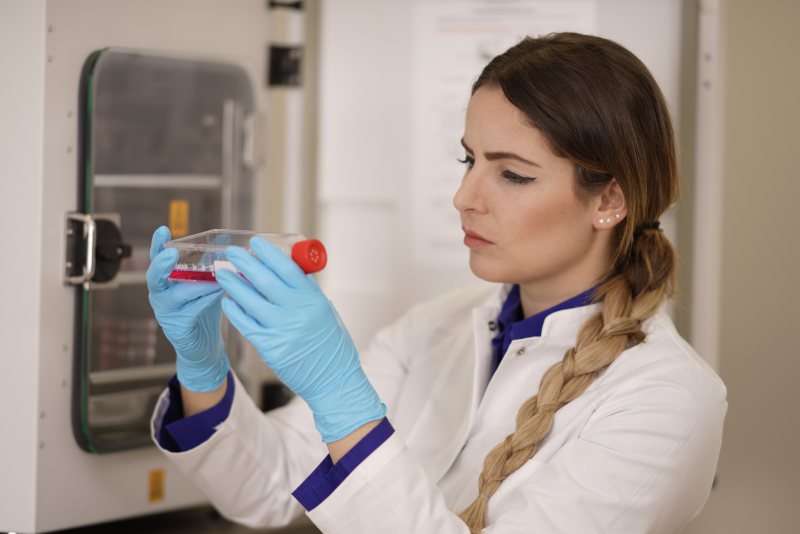
Cell detachment
Cell detachment is an essential process for the subcultivation of anchorage-dependent cells. As adherent cells grow, the substrate eventually becomes fully occupied. Also, the cell concentration might be too high for the capacity of the growth medium used. This is the time when cells must be split to prevent unwanted cell death by overpopulation.
Another scenario is the aggregation or clumping of cells, where cells must be detached from each other.
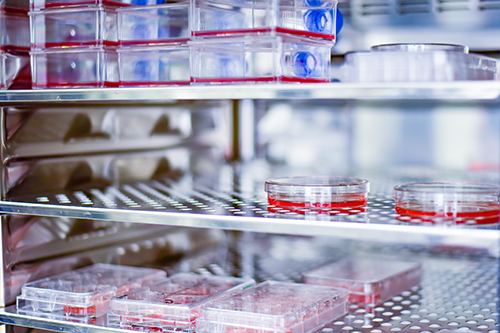
Cell adhesion
Cells usually possess a negative surface charge that is unevenly distributed and dependent on the current physiological state of the cell. In most cases, the cultivation surface has a negative charge and adhesion is believed to be mediated by protein bridges or ionic interactions (e.g., via Ca2+).
Protein bridges, also called substrate adhesion molecules, have receptors on the cell side, as well as adhesion molecules on the substrate side. There are roughly 30 adhesion molecules, such as collagen, fibronectin, laminin, and vitronectin.
Enzymatic cell detachment
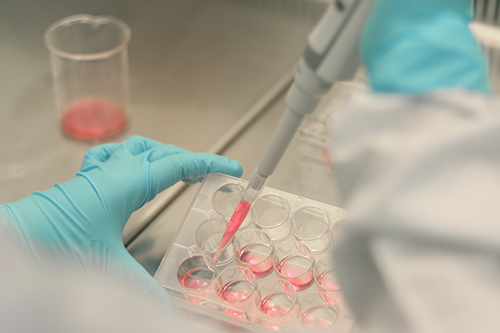
By far the most common way to detach cells is via trypsinization.
Trypsin is a cheap proteolytic enzyme, usually extracted from the pancreas of pigs (porcine trypsin), and has been used successfully for various applications. Also, it can be inactivated by serum, which is very convenient for cell culture.
Yet, the use of trypsin is considered to be a harsh method of detaching cells. Many researchers claim AccutaseTM to be a “softer” option of cell detachment when compared to trypsin.
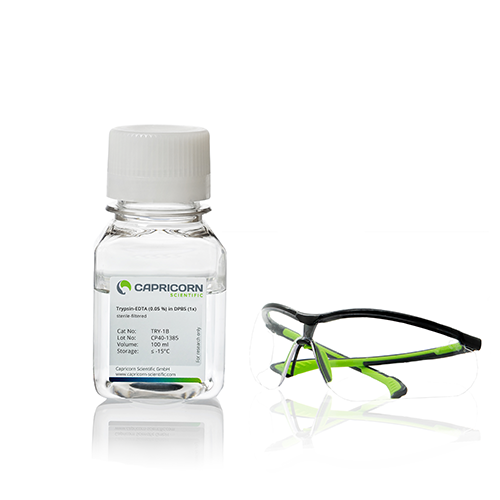
Trypsin
Trypsin is a serine protease of animal origin. It breaks down the anchorage proteins that attach the cell to the culture vessel. After roughly 5 minutes, the cells will appear rounded and are now in suspension.
To complete the process of passaging, the effects of trypsin have to be inhibited by serum or other inhibiting molecules, such as soybean trypsin inhibitor. It is advisable to rapidly wash the cells and dilute the solution after detachment – a step that is not necessary when using Accutase™.
Undesirable effects of trypsin
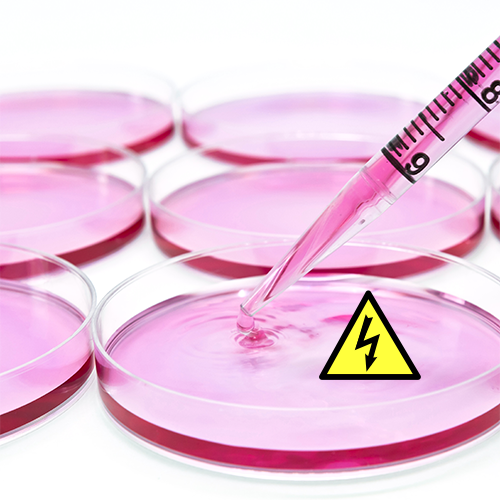
Trypsin introduces various unwanted side effects. After trypsinization, large quantities of glycopeptides, sulfated glycosaminoglycans, and hyaluronic acid can be found outside the cell. Also, trypsin leads to the release of a large portion of the cells’ total sialic acid.
Exposing cells to trypsin for a prolonged time will damage them. The surface will suffer damage and internally the cell will be harmed, e.g., degradation of polyribosomes.
Usually the cell will recover, but keep in mind that you want your cells to be in a stress-free state to gain reliable experimental data that is not altered by the side effects of trypsin.
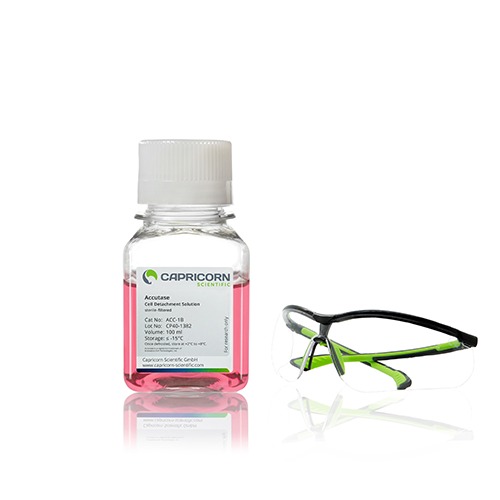
Accutase™
Accutase™ serves as a direct replacement for trypsin and collagenase applications:
- mix of proteolytic and collagenolytic enzymes
- no mammalian or bacterial origin
- inactivation step (e.g., serum or trypsin inhibitor) is not required
- preservation of cell epitopes
The efficiency is way higher than mammalian trypsin and collagenase, therefore Accutase™ can be used at a much lower concentration, making it less damaging to the cells.
Further, Accutase™ is:
- very simple (ready-to-use) in the handling
- stable at +4 °C for two months
- does not need to be aliquoted
- a great replacement for trypsin/EDTA applications.
Apart from cell detachment, Accutase™ can also be used to dissociate cell clumps. If the dissociation with Accutase™ is not successful, we recommend that you try Accumax™, which contains the same proteolytic enzymes but at a higher concentration.
Frequently Asked Questions (FAQ)
What is the difference between Accutase™ and Accumax™?


Accumax™ contains the same enzymes as Accutase™ (proteolytic and collagenolytic) but at a higher concentration (3-fold). Further, Accumax™ comes without phenol red.
In general, you can use Accutase™ for all of your trypsin applications. Should you experience difficulties in dissociating cell clumps, you can try Accumax™ instead, which usually does the trick.
My Accutase™ has a different color than expected. Is it still OK to use?


The color of your Accutase™ is caused by phenol red, which depends on the pH. During shipment, it is possible that small amounts of CO2 permeate into the plastic bottle that could change the pH, resulting in a slightly lower pH (turning yellow).
The original pH is 7.3, yet changes to pH 6.8 can occur during transport. This is nothing you need to worry about, as it will not affect the performance of your Accutase™.
My Accutase™ has an uneven color distribution within the bottle. Is it still OK to use?


Yes, it is still OK to use.
The individual components do not defrost evenly, therefore it is possible that you can observe uneven color distribution within the bottle. Just make sure to mix well by shaking gently (preferably by inverting), once the product is fully defrosted.
Can Accutase™ be used to dissociate non-adherent cell clumps?


Yes, you can use Accutase™ to dissociate cell clumps.
If you should not succeed using Accutase™, you can use Accumax™ instead. It contains the same enzymes but at a higher concentration.
I did not defrost my Accutase™ properly. Can I still use it?


If you defrosted your Accutase™ in a +37 °C water bath and the temperature did not reach +37 °C, it may still be OK to use (reduced activity is possible). If you heated the product to +37 °C, it will definitely have lost its enzyme activity.
Please observe whether your Accutase™ is still useable and discard the damaged product if necessary.
Do I need to wash my cells before or after using Accutase™?


No, this is not necessary.
Before detachment, simply pour off/aspirate the medium and add Accutase™. After detachment, you can simply add fresh medium to your detached cells.
How long should I incubate my cells with Accutase™?


The incubation times are similar to trypsin, you can simply proceed the way you are already used to doing it!
Do not worry about overexposing your cells to Accutase™ – it is very gentle, and your cells shouldn't take any damage, even when exposing them for a prolonged time.
We advise you to determine the optimal detachment/exposure time for your cells individually!
Instructions for Use
Accutase™: Standard Cell Passaging Protocol


Accutase™ is a ready-to-use product, and you do not need to further dilute it before use. Do not pre-warm to +37 °C!
We advise you to not be stingy when using Accutase™ and use enough product, as opposed to detaching the cells mechanically (by pipetting up and down) – this can damage and kill your cells!
- Remove medium from culture vessel by aspiration and wash the cells with a Ca2+- and Mg2+-free salt solution (e.g. Dulbecco’s PBS w/o Ca & Mg; Cat. No. PBS-1A). Remove salt solution by aspiration.
- Add Accutase to the culture dish or flask using aseptic procedures, using 10 ml for each 75 cm² of surface area.
- Allow cells to detach for 5 – 10 minutes at room temperature (RT). The precise time needs to be determined for each cell line and should not exceed a maximum of one hour.
- Observe the cells: once rounded, gently tap the flask against the palm of your hand to dislodge any cells that remain attached.
- Count the cells and passage as usual, no additional washes or enzyme inhibitors are required.
How to defrost Accutase™ and Accumax™


When your Accutase/Accumax™ products arrive, they should be frozen (at least a small ice cube) and have a yellow color that changes to orange when defrosting.
Once unpacked, you can immediately refreeze the product or place it into the fridge for defrosting.
- Never defrost Accutase/Accumax™ in a +37 °C water bath – this will destroy the product!
- Defrost overnight in the refrigerator or place in a tub of cold tap water for ~ 1.5 hours.
- After defrosting, always remember to shake the bottle. The individual components do not go into solution evenly when defrosting!
- Accutase/Accumax™ is stable in the refrigerator for 2 months, therefore aliquotation is not necessary. Yet, refreezing aliquots is possible.
Accutase™: Dissociation of adherent human or rat NSCs


- Aspirate the medium from culture dish.
- Add 2 mL of Accutase™ to culture dish.
- Incubate for 2 to 5 minutes at +37 °C until individual single cells start to round up.
- Gently rinse to remove cells off of the plate’s surface.
- Transfer cell suspension to 15 mL conical tube. Gently pipette up and down until cells are in a single cell suspension.
- Add 8 mL of medium to rinse any remaining cells off of the dish’s surface and transfer to the conical tube (from Step 5).
- Take a 20 µL sample of the cell suspension to determine viable cell density.
- Centrifuge conical tube containing the cell suspension at 200 x g for 4 minutes.
- Aspirate supernatant, resuspend in fresh medium and plate on coated dish(s). Incubate at +36 to +38 °C in a humidified atmosphere of 4 to 6 % CO2 in air.
Accutase™: Dissociation of human or rat neurosphere cultures


- Remove neurosphere cell suspension from culture dish and transfer to a 15 mL conical tube.
- Let neurospheres settle down in the tube (~2 to 5 minutes) before proceeding to Step 3. Alternatively, the cells can be centrifuged at 100 x g for 1 minute.
- Gently aspirate medium leaving the neurospheres at the bottom of tube with approximately 100 μL of media remaining.
- Resuspend neurospheres in 5 mL DPBS.
- Let neurospheres settle down in the tube (~2 to 5 minutes) before proceeding to Step 6. Alternatively, the cells can be centrifuged at 100 x g for 1 minute.
- Gently aspirate DPBS leaving the neurospheres at the bottom of tube with approximately 100 μL of DPBS remaining.
- Add 1 mL of Accutase™ to the neurospheres and incubate 10 minutes at room temperature.
- Using the proper sized pipette tip (i.e., 1000 µl), pipette up and down until all the neurospheres are in a single cell suspension.
- Add 4 mL of fresh medium to the tube.
- Centrifuge the cells at 200 x g for 4 minutes.
- Gently aspirate the supernatant.
- Resuspend cells in fresh medium, transfer to a new culture dish and incubate at +36 to +38 °C in a humidified atmosphere of 4 to 6 % CO2 in air.
Browse our gentle Detachment products
Accutase Cell Detachment Solution
Accumax Cell Dissociation Solution
YOUR BENEFITS AT A GLANCE
- direct replacement for trypsin applications
- no inactivation (e.g., with serum) necessary - save money!
- preserves most cell epitopes for subsequent analysis (e.g., FACS)
- stable at +4 °C for two months
- maximum cell viability/recovery & faster cell re-attachment time
TESTED CELL LINES
- hESCs, fibroblasts, keratinocytes, vascular endothelial cells, hepatocytes, vascular smooth muscle cells
- hepatocyte progenitors, primary chick embryo neuronal cells, bone marrow stem cells, adherent CHO and BHK cells
- macrophages, 293 cells, L929 cells, immortalized mouse testicular germ cells
- 3T3, Vero, COS, HeLa, NT2, MG63, M24 and A375 metastatic melanoma
- gliomas U251 and D54, HT1080 fibrosarcoma cells, and Sf9 insect cells
VERSATILE APPLICATIONS
- routine cell passage, cell proliferation, apoptosis, cell haptotaxis
- hESC culture, virus growth assay, transformation assays by oncogene transfection
- analysis of cell surface markers, tumor cell migration assays
- neural crest cell migration assays, production scale-up (bioreactor), flow cytometry
- high-throughput screening, quiescence assays by serum starvation
What reseachers say
about their experience with Accutase™
I like that Accutase is gentle on cells and auto-inhibits at +37 °C without the need for a neutralizing solution like with trypsin. Also, the cost of Accutase is less than trypsin + trypsin neutralizing solution, so it is cost-effective. It is also simpler to use, because it doesn’t require the extra neutralizing step, I just lift my cells in Accutase, then add them directly into fresh media.
I believe everyone in my lab now uses Accutase. We work with a wide range of cancer cells and neuronal cells too, and it works great.”
“We regularly use Accutase in cell culture and FACS applications using human embryonic stem cells and human induced pluripotent stem cells because these products give the best cell dissociation without compromising the health of our cells.
PRODUCT SPECIFICATIONS
| Appearance | Clear, pale red to orange solution (anything in between) |
|---|---|
| Storage and shelf life | (long term, ≤ -15 °C) (2 months after thawing, +2 to +8 °C) Do not store at room temperature. |
| Shipping conditions | (dry ice) |
| Working concentration | 1X (ready-to-use) |
| Origin | Crustacea |
FORMULATION
| Components | Concentration (mg/L) |
|---|---|
| EDTA 4Na | 220 |
| KCl | 200 |
| KH2PO4 | 200 |
| NaCl | 8000 |
| Na2HPO4 | 1150 |
| Phenol red | 3 |
| Accutase enzymes | 1 x |